深入浅出理解Java Lambda表达式之四大核心函数式的
目录
- 1.四大核心函数式接口
- 1.1 Consumer<T> : 消费型接口
- 1.2 Supplier<T> : 供给型接口
- 1.3 Function<T, R> : 函数型接口
- 1.4 Predicate<T> : 断言型接口
- 2.方法引用
- 2.1 对象 :: 实例方法
- 2.2 类 :: 静态方法
- 2.3 类 :: 实例方法
- 3.构造器引用
- 4.数组引用
1.四大核心函数式接口
上一篇文章中说到了Lambda表达式中的基本语法,以及我们如何自定义函数式接口。但是在写代码的过程中,大家可能会发现一个问题:当我们有一个新的需求时,可以去自定义一个函数式接口,然后再创建一个它的实现类定义一些相关的业务逻辑行为。那么如果说我们有很多需求、这些需求可能还会不断地变化,那么我们岂不是每次都要去创建新的实现类、同时再去修改之前创建好的实现类中的业务代码?这可太麻烦了吧。。。
所以呢,Java8就为我们提供了四大核心函数式接口,使用起来非常的方便。
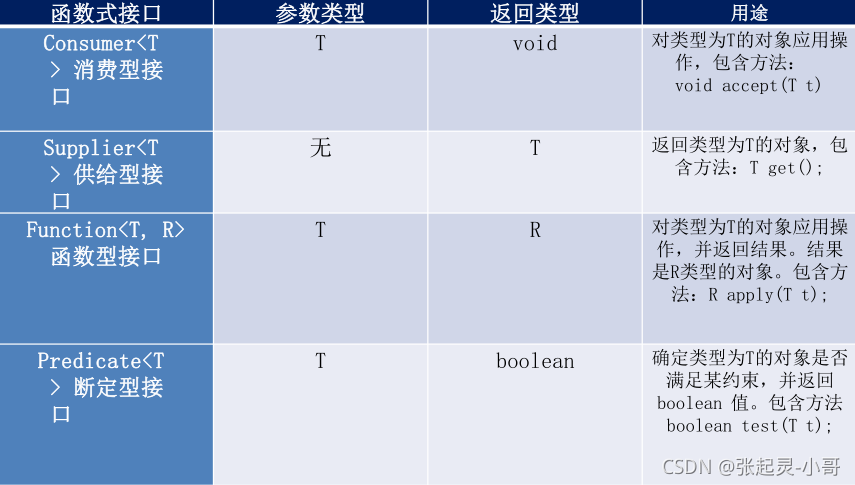
1.1 Consumer<T> : 消费型接口
package com.szh.java8;
import org.junit.Test;
import java.util.ArrayList;
import java.util.Arrays;
import java.util.List;
import java.util.function.Consumer;
import java.util.function.Function;
import java.util.function.Predicate;
import java.util.function.Supplier;
/*
*
*/
public class MyTest3 {
//Consumer<T> : 消费型接口
@Test
public void test1() {
happy(6666.66,(m) -> System.out.println("本地双11共消费 " + m + " 元!!!"));
}
public void happy(double money, Consumer<Double> consumer) {
consumer.accept(money);
}
}

1.2 Supplier<T> : 供给型接口
package com.szh.java8;
import org.junit.Test;
import java.util.ArrayList;
import java.util.Arrays;
import java.util.List;
import java.util.function.Consumer;
import java.util.function.Function;
import java.util.function.Predicate;
import java.util.function.Supplier;
/*
*
*/
public class MyTest3 {
//Supplier<T> : 供给型接口
@Test
public void test2() {
List<Integer> numList = getNumList(10, () -> (int)(Math.random() * 100));
for (Integer num : numList) {
System.out.println(num);
}
}
public List<Integer> getNumList(int num, Supplier<Integer> supplier) {
List<Integer> list = new ArrayList<>();
for (int i = 0; i < num; i++) {
Integer n = supplier.get();
list.add(n);
}
return list;
}
}
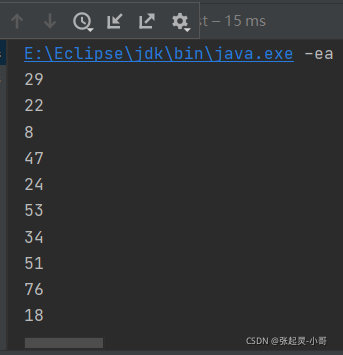
1.3 Function<T, R> : 函数型接口
package com.szh.java8;
import org.junit.Test;
import java.util.ArrayList;
import java.util.Arrays;
import java.util.List;
import java.util.function.Consumer;
import java.util.function.Function;
import java.util.function.Predicate;
import java.util.function.Supplier;
/*
*
*/
public class MyTest3 {
//Function<T, R> : 函数型接口
@Test
public void test3() {
String trimStr = strHandler("\t\t\t 张起灵-小哥 ", (str) -> str.trim());
System.out.println(trimStr);
String newStr = strHandler("我喜欢看盗墓笔记呀!!!",(str) -> str.substring(4,8));
System.out.println(newStr);
}
public String strHandler(String str, Function<String,String> function) {
return function.apply(str);
}
}
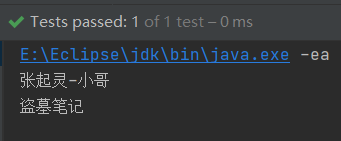
1.4 Predicate<T> : 断言型接口
package com.szh.java8;
import org.junit.Test;
import java.util.ArrayList;
import java.util.Arrays;
import java.util.List;
import java.util.function.Consumer;
import java.util.function.Function;
import java.util.function.Predicate;
import java.util.function.Supplier;
/*
*
*/
public class MyTest3 {
//Predicate<T> : 断言型接口
@Test
public void test4() {
List<String> list = Arrays.asList("Hello","张起灵-小哥","HashMap","jdk8","List","Set");
List<String> stringList = filterStr(list, (s) -> s.length() > 5);
for (String string : stringList) {
System.out.println(string);
}
}
public List<String> filterStr(List<String> strings, Predicate<String> predicate) {
List<String> strList = new ArrayList<>();
for (String str : strings) {
if (predicate.test(str)) {
strList.add(str);
}
}
return strList;
}
}
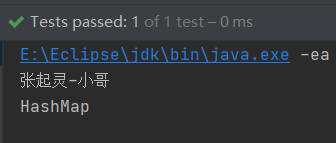
除此之外,还有一些其他的函数式接口,它们有一部分是上面提到的四大核心函数式接口的子接口。
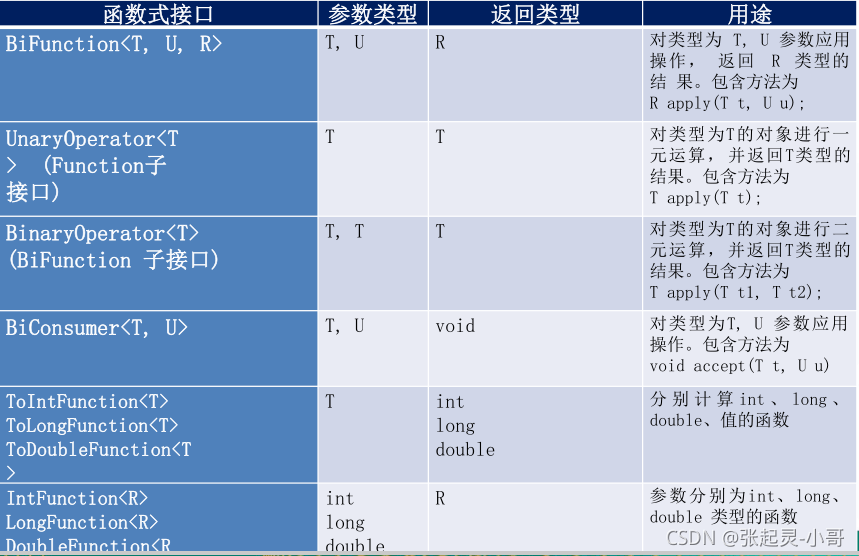
2.方法引用
当要传递给Lambda体的操作,已经有实现的方法了,可以使用方法引用! 方法引用:使用操作符 “ :: ” 将方法名和对象或类的名字分隔开来。
如下三种主要使用情况 :
- 对象 :: 实例方法
- 类 :: 静态方法
- 类 :: 实例方法
可以将方法引用理解为 Lambda 表达式的另外一种表现形式,方法引用所引用的方法的参数列表与返回值类型,需要与函数式接口中抽象方法的参数列表和返回值类型保持一致!
2.1 对象 :: 实例方法
@Test
public void test1() {
Consumer<String> con1 = (str) -> System.out.println(str);
con1.accept("Hello World!!!");
PrintStream ps = System.out;
Consumer<String> con2 = ps::println;
con2.accept("Hello Java8!!!");
Consumer<String> con3 = System.out::println;
con3.accept("Hello Lambda!!!");
}
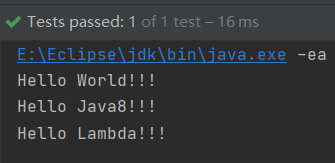
@Test
public void test2() {
Employee emp = new Employee();
emp.setName("张起灵");
emp.setAge(18);
Supplier<? extends Object> sup1 = () -> emp.getName();
String str = (String) sup1.get();
System.out.println(str);
Supplier<Integer> sup2 = emp::getAge;
Integer age = sup2.get();
System.out.println(age);
}
package com.szh.java8;
import lombok.AllArgsConstructor;
import lombok.Data;
import lombok.NoArgsConstructor;
/**
*
*/
@Data
@NoArgsConstructor
@AllArgsConstructor
public class Employee {
private Integer id;
private String name;
private Integer age;
private Double salary;
public Employee(Integer id) {
this.id = id;
}
public Employee(Integer id,String name) {
this.id = id;
this.name = name;
}
}
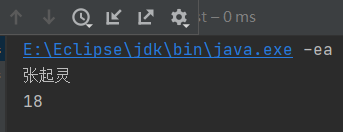
2.2 类 :: 静态方法
@Test
public void test3() {
Comparator<Integer> com1 = (x,y) -> Integer.compare(x,y);
System.out.println(com1.compare(10, 20));
Comparator<Integer> com2 = Integer::compare;
System.out.println(com2.compare(300, 110));
}
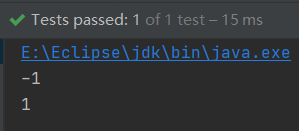
2.3 类 :: 实例方法
若 Lambda 的参数列表的第一个参数是实例方法的调用者,第二个参数(或无参)是实例方法的参数时,格式: ClassName::MethodName
@Test
public void test4() {
BiPredicate<String,String> bp1 = (str1,str2) -> str1.equals(str2);
System.out.println(bp1.test("Hello", "hello"));
BiPredicate<String,String> bp2 = String::equals;
System.out.println(bp2.test("Java", "Java"));
}
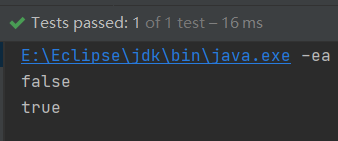
3.构造器引用
格式 : ClassName::new
与函数式接口相结合,自动与函数式接口中方法兼容。构造器的参数列表,需要与函数式接口中参数列表保持一致!
代码中Employee类参考上面的案例。
@Test
public void test5() {
//无参构造器
Supplier<Employee> sup1 = () -> new Employee();
System.out.println(sup1.get());
//无参构造器
Supplier<Employee> sup2 = Employee::new;
System.out.println(sup2.get());
//一个参数构造器
Function<Integer,Employee> function = Employee::new;
Employee employee = function.apply(1001);
System.out.println(employee);
//两个参数构造器
BiFunction<Integer,String,Employee> biFunction = Employee::new;
Employee emp = biFunction.apply(1001, "张起灵");
System.out.println(emp);
}
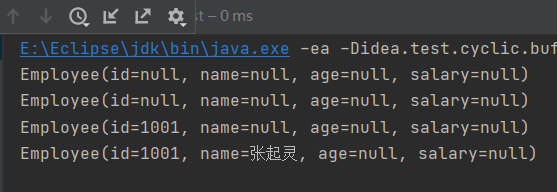
4.数组引用
格式 :类型[] :: new
@Test
public void test6() {
Function<Integer,String[]> fun = (x) -> new String[x];
String[] strings = fun.apply(10);
System.out.println(strings.length);
Function<Integer,String[]> fun2 = String[]::new;
String[] strArray = fun2.apply(50);
System.out.println(strArray.length);
}
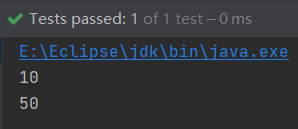
以上就是深入浅出理解Java Lambda表达式之四大核心函数式的用法与范例的详细内容,更多关于Java Lambda表达式的资料请关注自由互联其它相关文章!
【文章出处:cc防御 转载请说明出处】